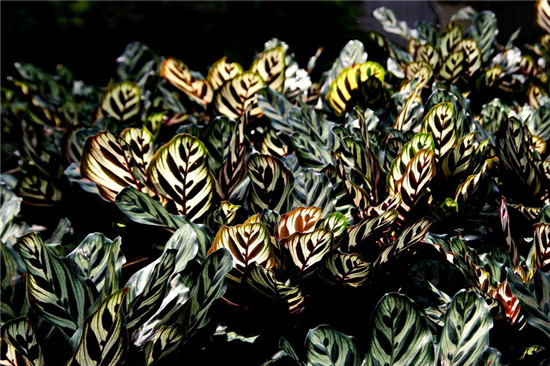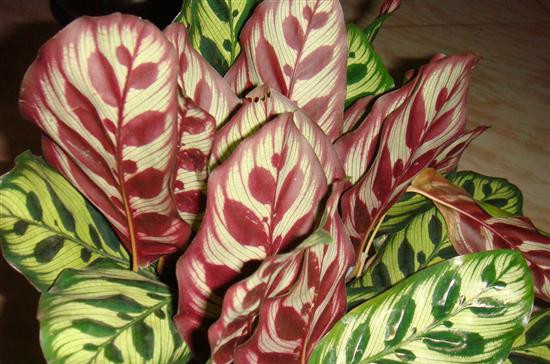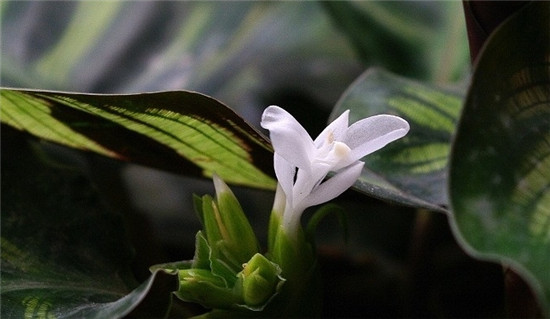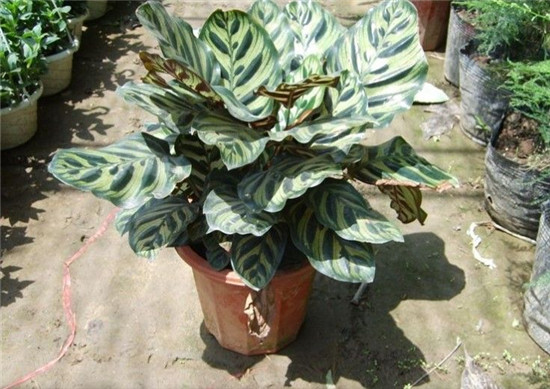Propagation method of peacock arrowroot
Peacock bamboo taro is a common family potted plant, many families put it indoors as an ornamental, and then let's take a look at the breeding of peacock bamboo taro.

Peacock bamboo taro is called blue flower coke. It is a more beautiful and exquisite herb. It is suitable to be placed in the office, while the large ones are suitable for viewing bonsai in the hallway. Perennial evergreen herbs. 30-60 cm high, 15-20 cm long and 5-10 cm wide, ovate-oval, thin, leathery, petiole purplish red.
The green leaves are faintly metallic and bright, and there are pinnate, dark green and long oval velvet patches along both sides of the midrib, arranged alternately from left to right. The leaf back is purplish red.
There are tubers at the base, the plant height is 30-50 cm. The leaves are ovate-elliptic, basal, entire, 20-30 cm long and 10 cm wide, dark purple, with white velvet; because the dense filamentous markings on both sides of the main vein of the leaf surface extend from the central vein to the margin of the leaf, showing a feathery arrangement, there are obvious small veins between the lateral veins similar to the tail feathers of peacocks, hence the name peacock taro; the ornamental spots on the back of the leaves are lilac, and the petiole is dark purple.

Cultivation and breeding: Peacock bamboo taro is suitable for full-day illumination in spring and autumn, while semi-shading is recommended in summer, and fluorescent lamp can be used to illuminate flowers in winter if there is little light. In general, it is recommended that the temperature is above 20 degrees Celsius, but the temperature is not higher than 35 degrees Celsius, because it will be burned. The leaves curl because of the high temperature. No less than 5 ℃ in winter. Peacock bamboo taro likes a humid environment, so it is recommended that the humidity of bamboo taro be kept at about 70%. Growth should be fully watered to maintain the moisture of the soil, but be careful not to accumulate water.
Daily maintenance: if the peacock taro found that its plant is relatively small flowers, and the markings are dim, then it shows that it is lack of fertilizer, it is generally recommended to apply fertilizer once every 20 days during the growing period, and it is recommended to apply thin fertilizer. It is recommended to stop fertilizing when you stop growing in winter and summer. Watering as the most important part, the growing period should be fully watered, but not stagnant water. After flowering, attention should be paid to watering control. Dry rewatering is generally recommended.

Cultivation precautions: Peacock bamboo taro is a shallow root plant, before planting or transplanting, you can choose a large shallow pot as a potted choice, the soil suggests sand mixed with garden soil, preferably containing some corrosive matter. The time of changing the basin is generally controlled at once every two years. Attention must be paid to maintenance in winter, because if it is watered too much or the temperature is low in winter, it will cause death.
How to raise the leaves of peacock taro: the humidity of peacock taro should be controlled in the family. Outside summer and winter, it is recommended to spray and wash every 3-5 days. If there is a greenhouse, you can also increase the humidity by raising the temperature of the greenhouse. In order to make the leaf color gorgeous, it is recommended to apply dilute liquid fertilizer every 3-4 weeks during the growth period, and to irrigate the nutrient solution once or twice a month. The most important thing is to expose more sunlight. Because it is kept in a dim light for a long time, the leaves will lose their unique gorgeous luster. In daily attention, clean water is often used to gently scrub the leaves. Only by doing the above, can we keep the peacock bamboo taro leaves beautiful.

Peacock bamboo taro function: the most important thing is the ornamental value of peacock bamboo taro. Its leaves are not only beautiful, but also resistant to shade or Zhao Guang. The growing leaves are clustered together, making them ideal for family planting and greening. Whether it is a large group or a single peacock taro is very good-looking. Many people like small potted plants and put plum blossoms next to the computer.
The efficiency of removing formaldehyde of peacock bamboo taro is half of that of hanging orchid, but it is also much higher than that of ordinary plants. in addition, it is also a master of removing ammonia pollution in the air (it can remove formaldehyde 0.86mg and ammonia 2.19mg within 10 square meters).
These are all the contents of the breeding methods of peacock taro that I have summarized for you. I hope this article can help you. Please continue to follow us.
Related
- Wuhan Hospital Iron Tree Blooming Result Was Instantly Frightened by the Gardener Master
- Which variety of camellia is the most fragrant and best? Which one do you like best?
- What is the small blue coat, the breeding methods and matters needing attention of the succulent plant
- Dormancy time and maintenance management of succulent plants during dormancy
- Minas succulent how to raise, Minas succulent plant pictures
- What are the varieties of winter succulent plants
- How to raise succulent plants in twelve rolls? let's take a look at some experience of breeding twelve rolls.
- Attention should be paid to water control for succulent plants during dormant period (winter and summer)
- Watering experience of twelve rolls of succulent plants
- Techniques for fertilizing succulent plants. An article will let you know how to fertilize succulent plants.



